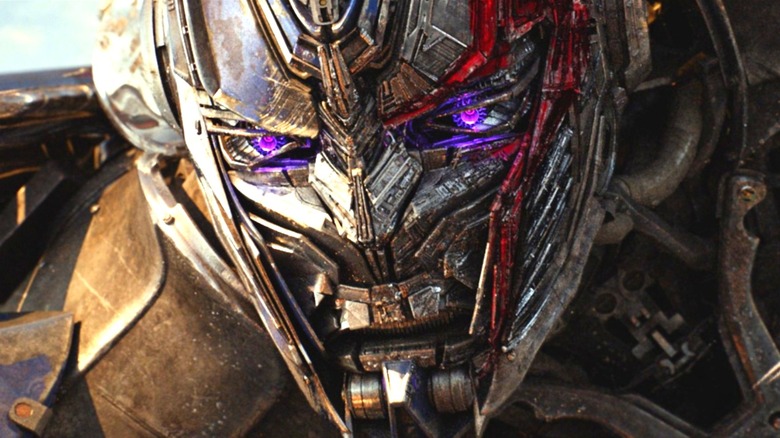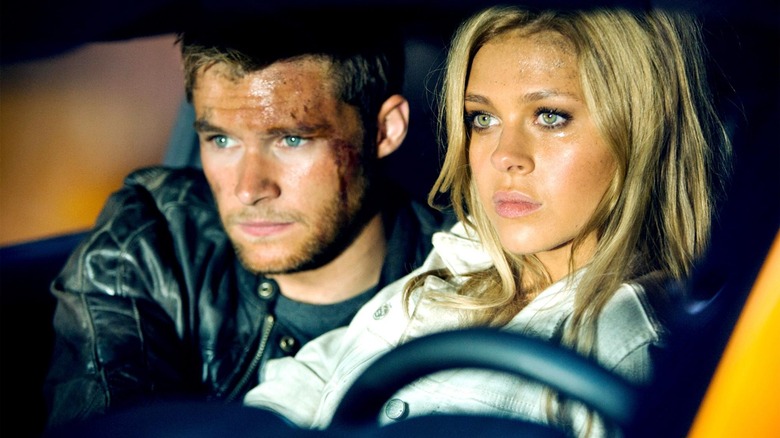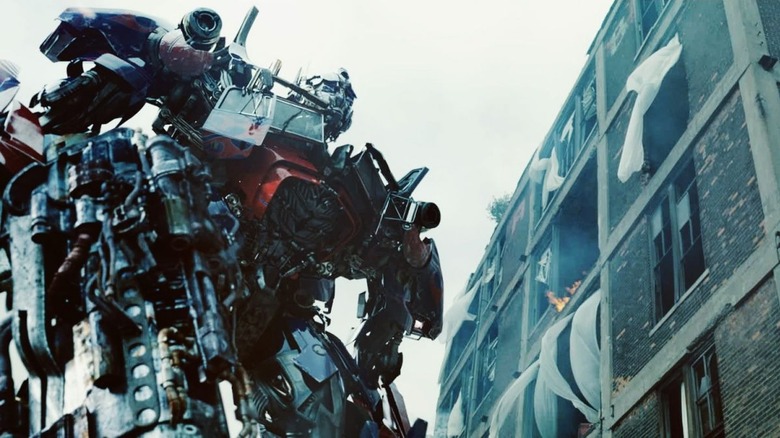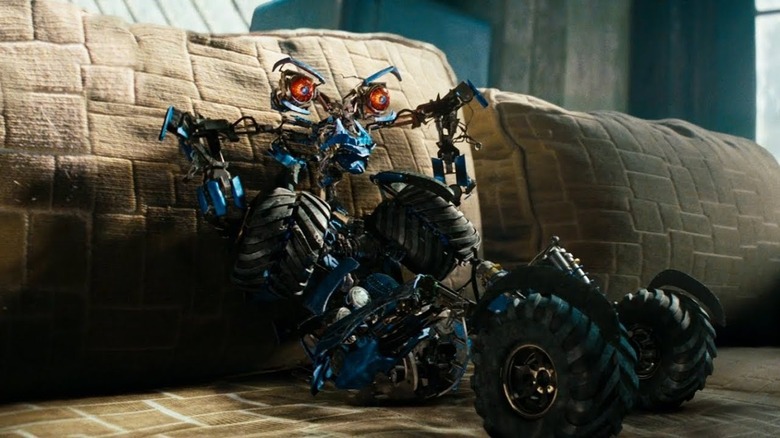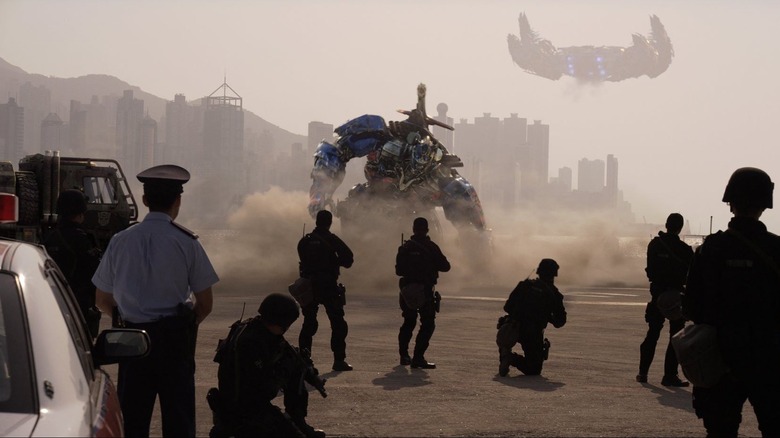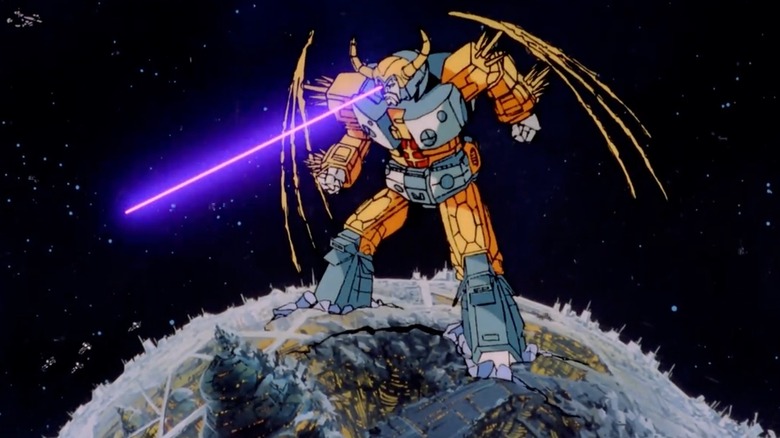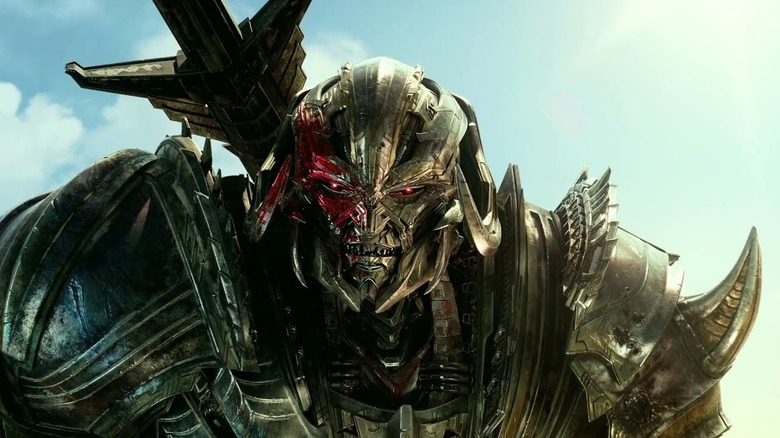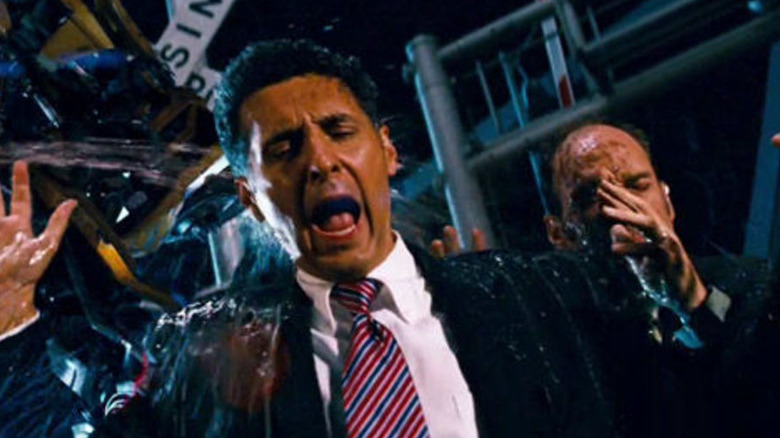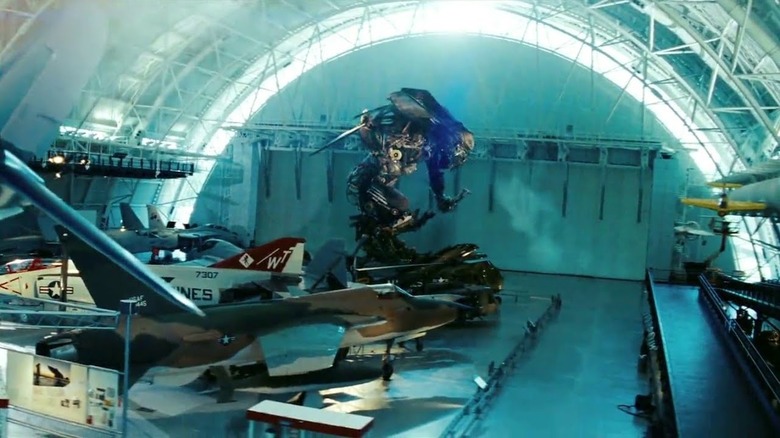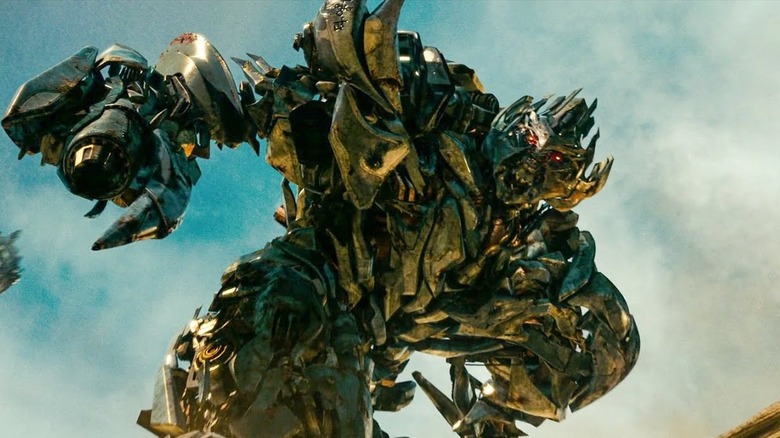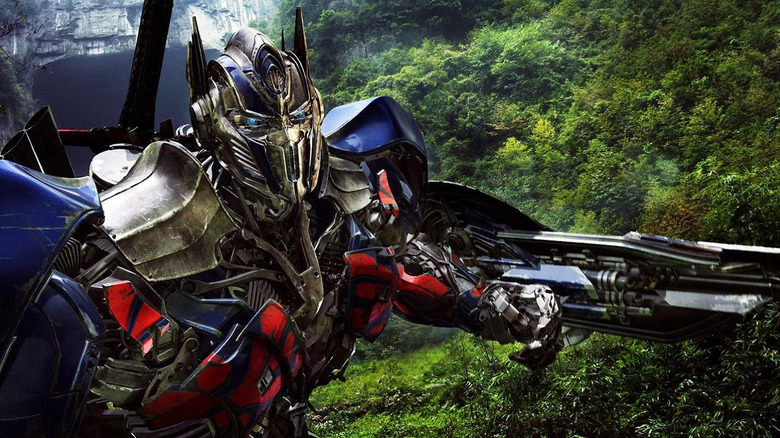Questionable Moments In The Transformers Franchise
When you go to see a typical summer blockbuster, you're bound to expect explosions, fight scenes, maybe a quippy line of comedic dialogue or two. But one must readjust their expectations wildly when it comes to the "Transformers" movies, especially the ones directed by Michael Bay. For these productions, one must prepare for a barrage of elements you don't normally get in a big-budget tentpole, such as an odd emphasis on sexual innuendos, disorienting editing, and enough constant noise to make the average rock concert look like a stroll through a park. You don't just get a summer blockbuster with most of these "Transformers" films — you get a cacophony of mayhem.
All of that chaos has resulted in several moments in the "Transformers" movies that are questionable for a variety of reasons. Some resonate this way for how much they strain to have big CG robots deliver juvenile bathroom humor; others register as questionable because of the kind of cruel behavior being exhibited by characters that are supposed to be heroic. These are just two among many ways that countless moments in the "Transformers" series have emerged as being questionable.
The Romeo & Juliet law scene in Age of Extinction
After an elaborate chase scene, "Transformers: Age of Extinction" protagonist Cade Yaegar finally gets a chance to meet Shane Dyson, the man dating his daughter. As Yaegar points out, though, his offspring is a minor and Shane is 20 years old, which makes their relationship illegal. Ah, but Shane has a counterpoint to this, as he whips out from his wallet a laminated copy of the text for the "Romeo & Juliet Law," which makes the relationship legal because the two have, in the words of Dyson, a "preexisting juvenile foundational relationship."
In any movie, it'd be downright bizarre to pause the runtime to run down the logistics of this law. In a summer blockbuster largely aimed at children, it's even more so. This moment from "Transformers: Age of Extinction" sparked plenty of controversy, which has endured for so long that Jack Reynor, who played Shane, even spoke out about it in a 2019 interview. "When you look at the culture of it now, especially given the advent of the #MeToo era, yeah, it's definitely a problematic joke, but I'm not the writer of the film," Reynor said to Entertainment Weekly.
Optimus Prime's dismissal of humanity's casualties in Dark of the Moon
In the middle of "Transformers: Dark of the Moon," humanity sends the Autobots away on a rocket ship to persuade the Decepticons not to destroy the planet. Shortly after launching, the rocket is destroyed by Decepticon forces, who immediately proceed to take over Chicago as a part of their world-ending plans. After at least a day of chaos, Chicago is a war zone, countless lives have been lost, and now Sam Witwicky is on his way to save his girlfriend from an evil human hiding in the wreckage.
As Witwicky and his human allies enter the city, they're immediately met by Decepticon forces, who are quickly dispatched by a surprisingly alive Optimus Prime. He and the other Autobots have re-emerged, with Prime boasting that, having seen what happens when they're not around, the humans will now properly appreciate the Autobots. There are layers of disturbing details to this whole reveal, including the fact that these supposedly kindly robots allowed untold amounts of death just to feel "properly" appreciated. The callous disregard for the loss of human life is in keeping with Optimus Prime's nonchalant attitude towards dishing out extreme carnage in these movies. However, it's certainly not what one would expect from a conventional summer blockbuster hero.
Wheelie's big moment of affection
In the middle of "Transformers: Revenge of the Fallen," Decepticon Wheelie learns from elderly Transformer Jetfire that you can change sides in the war between robots in disguise. Given his affection for Mikaela Banes, Wheelie immediately defects to the team she belongs to, the Autobots. To celebrate this achievement, Wheelie gets down on his knees and begins kissing Banes' feet. He doesn't stop there. Wheelie then proceeds to then grind on her leg in a manner reminiscent of a canine.
There are many images that never needed to be seen in cinema. This is one. Wheelie's moment of sexual euphoria with Banes' leg is questionable, to say the least, and that includes how it feels out-of-character for this incarnation of the robot. As sources such as TFWiki have pointed out, the original version of Wheelie in "Revenge of the Fallen" (preserved through tie-in materials like the official novelization) saw him being more animalistic and talking in a simplified language. His "affectionate" behavior would still be gratuitous, but at least it would have been consistent with this initial iteration of the character. However, the final version of Wheelie is a streetwise fellow who has much intelligence as the human characters, making this sudden act of animalistic behavior drastically out of character. That's, of course, only just scratching the surface of the questionable parts of this sequence.
An Age of Extinction line praising the Chinese military
The constantly one-note portrayal of the U.S. military throughout the original trilogy of "Transformers" movies was always a troubling element of these productions. Director Michael Bay seemed to be using movies aimed at children as an opportunity to provide extended commercials for the Armed Forces. The uncomfortable approach to the U.S. military was recycled for "Transformers: Age of Extinction," though this time it was used for the Chinese military.
A co-production with China, "Transformers: Age of Extinction" features many scenes that are meant to be favorable towards the country. The most notable example of this comes when one character working for the Chinese government notes that the Chinese military will always "step in to protect Hong Kong."
While most of the movie's nods towards China are of the harmless variety (like Stanley Tucci slurping a beverage exclusive to the country), this particular line has always been extremely questionable. Prior "Transformers" movies just vaguely praised the U.S. military, whereas this one uses a shallow heroic depiction in the service of specific real-world geopolitical interests. It's especially egregious in 2021, thanks to an increased worldwide awareness of how the Chinese military has treated pro-democracy Hong Kong protestors. Bay's "Transformers" movies have always had uncomfortably one-note worship of military forces, but in "Age of Extinction," it got taken to an especially unsettling level.
The clumsy reveal that Earth is Unicron in The Last Knight
"Transformers: The Last Knight" divulges lots of new information regarding the history of Transformers on Earth, including the fact that the likes of Harriet Tubman and Frederick Douglass working alongside these robots. However, we also get the revelation that the Earth itself is a Transformer. Specifically, Earth is Unicron, a long-dormant robot that the malicious Quintessa wants to awaken with the aid of an evil Optimus Prime.
This is a gauntlet-throwdown of a moment in several ways, including its sudden introduction of one of the most iconic "Transformers" villains as well as how it increases the scale of this movie's enemies dramatically. However, it's also a revelation that proves questionable, especially since it's puzzling why none of the other robots, particularly the Decepticons, have ever known about Earth being Unicron. Plus, despite a brief threat of Unicron waking up to wreak havoc, the robot never makes an appearance here beyond the horns on his head poking out from the ground. In the end, rather than using this jaw-dropping development to take its story to new places, the use of Unicron in "The Last Knight" is just another superfluous attempt to amp up the stakes of its climax by invoking a familiar piece of lore.
Galvatron ditching his own name in The Last Knight
In "Transformers: Age of Extinction," human scientists inadvertently bring Megatron back from the dead with their corporate experiments. This revived version of the character decides to rechristen himself with the name Galvatron. "Transformers" fans will recognize this as a homage to how Megatron was also renamed Galvatron once he was rebuilt in the 1986 cartoon "Transformers: The Movie." That name stuck around in that canon, leading fans to believe Galvatron would also endure in the live-action films. This would also fit in with the original intentions of using "Age of Extinction" as not necessarily a reboot but a way of re-energizing the "Transformers" franchise with new energy, including with a fresh name for its principal antagonist.
When the next movie, "Transformers: The Last Knight," rolled around, though, Galvatron was suddenly no more. Inexplicably, he was now being called Megatron again, with no in-universe reason offered for what caused this change and why. The human and robot characters alike just started referring to him as Megatron again, with everything about the character from "Age of Extinction" seemingly wiped from memory. While it wasn't like the Galvatron form of this live-action villain had become beloved, it was yet another instance of the Michael Bay "Transformers" movies playing so fast and loose with continuity that it was hard to care about what happened onscreen. Though Galvatron ended "Age of Extinction" proclaiming he'd been "reborn," apparently, that rebirth was only temporary.
Bumblebee 'urinating' on Seymour Simmons
For a little while in the first Michael Bay "Transformers" movie, Seymour Simmons seems like an intimidating figure who could rain down relentless hardship on the lives of Sam Witwicky and his loved ones. But that gets undercut once Bumblebee and the Autobots catch up to Simmons, who, along with his fellow Sector Seven agents, have been driving Witwicky and Mikaela Banes for questioning. After Simmons has been ordered out of his automobile, the formidable agent tries to reassert his authority ... only for Bumblebee to emit a long stream of liquid from the lower half of his body.
It's apparent to anyone over the age of two that this is meant to be a robotic approximation of urination, an example of aggressive bathroom humor intended to undercut the intimidating persona of Simmons. However, it's more puzzling than hysterical, mostly because it suddenly introduces the idea of Transformers having robotic equivalents to human genitalia. It's also a superfluous moment that gets sandwiched in between a pair of intense scenes concerning Witwicky learning about Banes' criminal history and a later moment where Bumblebee gets subdued by Sector Seven agents. In the middle of these more intense moments, though, is Bumblebee urinating on Emmy-winning actor John Turturro. So much for Simmons being a figure to be reckoned with.
Confusing geography in Revenge of the Fallen
In "Transformers: Revenge of the Fallen," Sam Witwicky and his human allies need a little help from a Seeker, a legendary older Transformer with valuable information. One such robot is located in the Smithsonian Air and Space Museum and is named Jetfire. Just as this big robot with a faulty memory is reawakened, though, the humans notice a Decepticon insignia on his side. Fearing death, the human characters hide, and the reawakened Jetfire seemingly lives up to his evil colleagues by immediately causing chaos. Smashing nearby objects in the museum, Jetfire's reign of terror moves to exterior locations when he bursts through a nearby wall.
Naturally, viewers might now expect Jetfire to continue his violent rampage by wandering over to the Lincoln Memorial or other exterior landmarks near the Smithsonian. Instead, he suddenly ends up in an airplane graveyard that's actually located in Arizona, with the film pretending that such a location exists on the Smithsonian grounds. Never mind the fact that the terrain of Arizona is starkly different compared to Washington, D.C., or that the expansive museum has suddenly vanished entirely. "Revenge of the Fallen" doesn't even try to digitally insert other parts of Washington D.C. into the background of this sequence. Even for a movie about ancient talking robot aliens, this sudden shift in geography is distracting and evocative of the kind of slipshod filmmaking that dragged down "Revenge of the Fallen."
The AllSpark reviving Megatron after killing him
The entire finale of the first "Transformers" movie hinges on the fact that the AllSpark, when jabbed directly into the chest of a Transformer, will kill the robot instantly. Optimus Prime initially brings this up to urge Sam Witwicky to place the object in his chest if the Decepticons get too close to retrieving it. In the end, Witwicky places himself in great jeopardy to put the AllSpark into Megatron, who is promptly killed by this close encounter with the prized object.
This at least consistent approach with the AllSpark from the first movie is abandoned for "Revenge of the Fallen." This film features the return of Megatron by way of a group of Decepticons traveling to the bottom of the ocean and placing a shard of the AllSpark inside Megatron's chest. An object that previously proved fatal to the Decepticon has now revived him, the robotic equivalent of drinking bleach and then hanging onto life by guzzling even more of it. There isn't even an attempt in the movie to hand-wave away why the AllSpark revives Transformers rather than instantly kill them. It's just one of several puzzling details in the feature that confound instead of thrill.
Optimus Prime threatening to kill the Dinobots
Just over two hours into "Transformers: Age of Extinction," the Dinobots, a central part of the movie's marketing, finally show up in the feature. As they emerge from a ship belonging to robot bounty hunter Lockdown, the beasts begin to rebel against Optimus Prime. This is a natural response, given how poorly they've been treated, as well as the fact that they've spent so long trapped. The leader of the Autobots hasn't freed these beasts out of the goodness of his heart, though. Instead, he has an awfully specific purpose in mind for these prehistoric robots: to use them in a battle against Lockdown and Galvatron.
To make this point clear, Prime doesn't deliver a stirring speech or offer a reward for the Dinobots providing aid. Instead, Prime bellows to them that they will either join his side or die. That's it. Optimus Prime in the "Transformers" movies once again resorts to extreme violence to make a point. After a quick skirmish between Prime and Grimlock that makes the Autobot's threats of violence extra apparent, the Dinobots then serve as loyal warriors for Prime and company. Prime even charges into battle on the back of Grimlock. The film ends with slightly warmer dynamics between the Dinobots and certain Autobots like Crosshairs. To get to that point, though, "Age of Extinction" had to include a questionable instance of Prime using murder as a threat to corral these creatures to his side.
